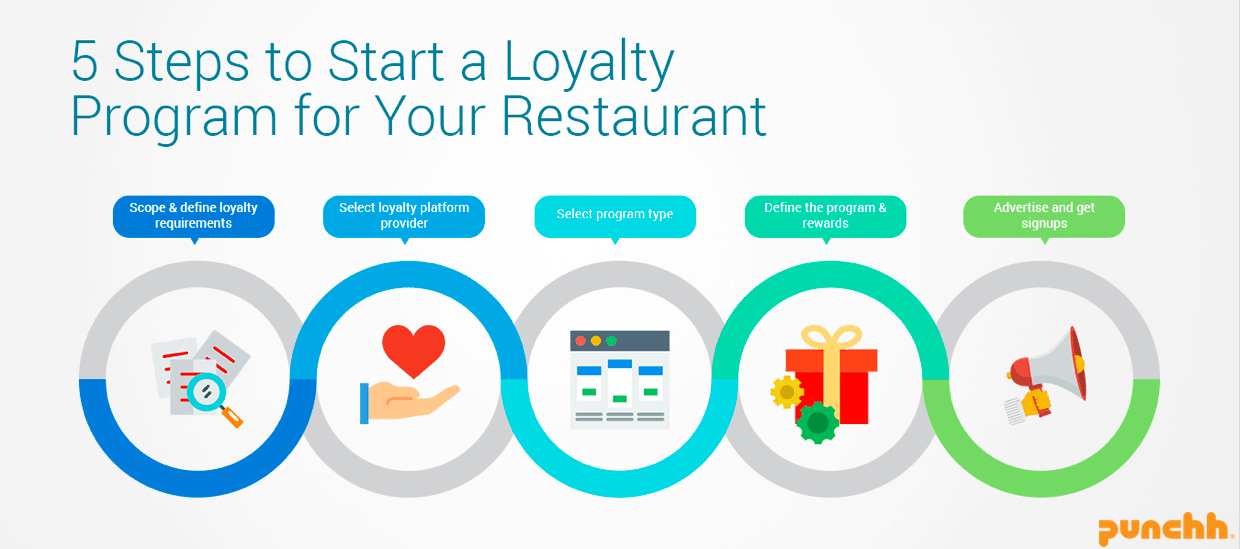Restaurants roll out loyalty programs because they know two things:
- Acquiring new guests can be more expensive than retaining returning guests
- Loyal guests can drive higher sales revenues compared to new or infrequent guests
OK, we know there are other reasons to justify the need of a loyalty program, but the bottom line is most restaurants want to retain more guests, increase guests’ visit frequency and ultimately gain incremental revenue. The success and effectiveness of a loyalty program, however, can be greatly dependent on how you conceptualize and configure it, what platform you choose to enable it and how you promote it to your guests. These five simple steps should help you design and implement a loyalty program for your restaurants:

- Define the Scope and Requirements for Your Loyalty Program
Before investing in building a loyalty program, restaurant marketers need to first study the buying behavior, demographics and preferences of guests. To be able to do this effectively, you should have a customer data management solution in place that allows for the automated collection of guest data. With sufficient data, you can easily profile your guests and design a loyalty program that suits their behavior and demands.
Once you have a good handle on who your guests are and what they like, it’s important to then identify specific objectives and requirements for rolling out a loyalty program. Ask yourself: Who are the target guests? What are the participating branches? What is the minimum and/or maximum number of guests to target in order to see positive ROI on your investment? How much budget will need to be allocated for this? How do our guests like to engage with our brand today?
Once you’ve answered these important questions, your marketing team will be able to conceptualize a loyalty program that can best cater to your customers’ preferences and expectations.
- Select a Loyalty Platform Provider
This step is crucial because the quality of the platform and the industry expertise of the provider can greatly affect the success of your loyalty program. Elizabeth Skipor, a Consultant at Source One Management Services, advises restaurants to consider the technical capabilities of any provider, saying, “The provider should have the ability to deliver an easy-to-use customer interface via Web and mobile and real-time data updates for business employees to be able to view and address any account management questions via your consumers.” In addition, Skipor suggests choosing a provider with a robust reporting and analytics tool for loyalty programs so your brand can effectively gauge the success of the program.
It’s also important that the provider you select can become a trusted partner that can grow and scale with your business and support different types of programs as guest expectations evolve over time.
- Design Your Loyalty Program
There are several different types of loyalty programs available today, including points-based rewards program, visits-based rewards program, tiered membership programs and surprise and delight programs. Using your data and guest analysis from step one, you can choose the loyalty program you think will best meet your guests’ expectations and requirements. For more information on the different types of loyalty programs restaurants can create, check out this blog post.
- Define and Configure the Program and Rewards
Tailor the program and reward system with respect to your frequent guests, business objectives and chosen type of loyalty program. It’s important to ensure that the “rewards” and other promotional offers you’re giving out are of enough value to the customer, but are also cost effective relative to your overall KPIs and revenue goals. It’s important to set up your program such that you’re able to understand the overall effectiveness of your program, the ROI it’s generating and the overall effect the program is having on retaining and growing your customer base overall.
Although baby boomers make up a large and lucrative group of potential patrons that shouldn’t be ignored, restaurants today should also pay attention to the preferences of Millennial and Generation Z guests, both of which have buying power of $65 billion and $143 billion respectively. Surveys reveal that both Millennial and Gen Z guests join loyalty programs that offer a variety of rewards that accrue quickly, according to Software Advice, offer a variety of rewards that accrue quickly. They sign up for rewards that are based on their purchase history and offer higher discounts and better value. They also prefer automated rewards signup and redemption via their smart devices, prepaid debit and gift cards.
- Advertise and Incentivize Signups
As smartphone adoption by consumers has exponentially increased in the past few years, it’s important to choose a loyalty platform that puts mobile engagement at the heart of your program. As more and more guests prefer to engage with brands using their mobile devices, this functionality can be very effective for not only advertising your loyalty program but also incentivizing guests to join. Make sure the platform you invest in allows for immediate and automated notifications and feedback to keep your guests engaged.
Loyalty programs are a great way to enhance guest loyalty and thereby increase sales while minimizing costs. To roll out a loyalty program for your restaurant that truly converts, strategically craft your program using a platform purposefully designed by experts in the restaurant industry.
For more information on how Punchh can help power your loyalty program, contact us to schedule a demo with one of our experienced sales associates.
Stay in the know. Subscribe to our bi-monthly newsletter to receive proven loyalty strategies, offer management techniques, and new trends in your industry. Sign up today!